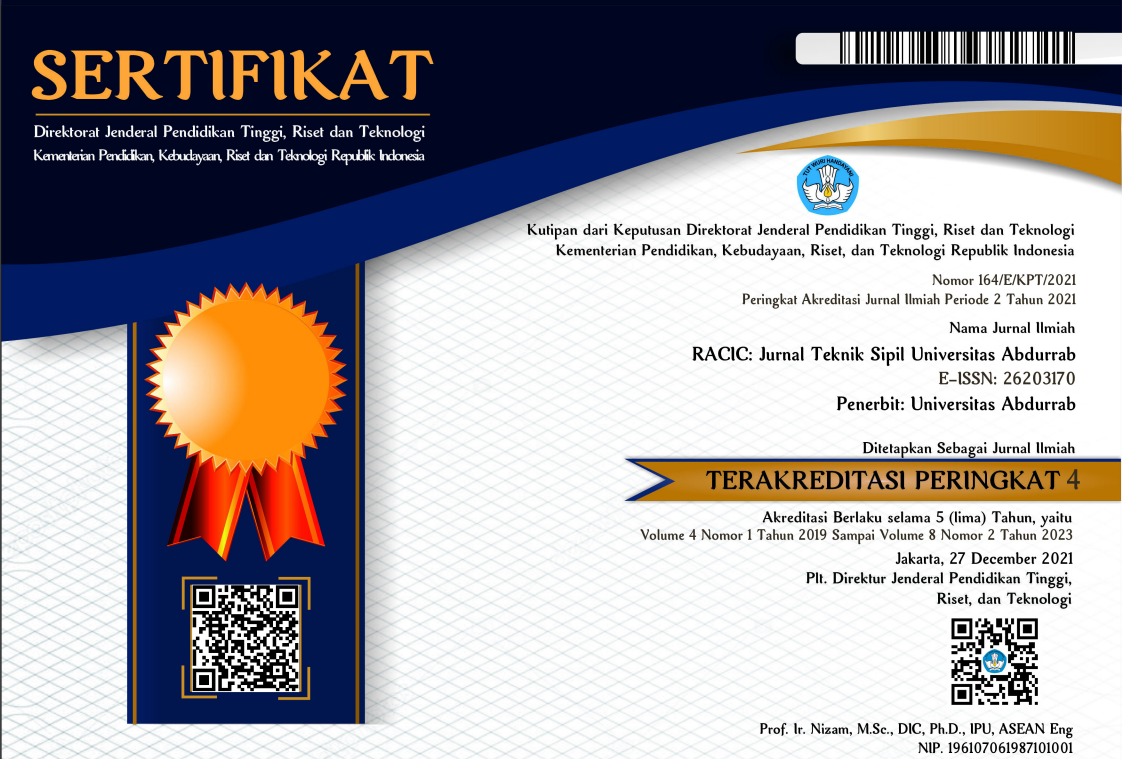PENGATURAN ZONASI DI DAERAH SEMPADAN SUNGAI MANDAR, KECAMATAN TINAMBUNG KABUPATEN POLEWALI MANDAR
DOI:
https://doi.org/10.36341/racic.v7i2.2997Keywords:
zoning arrangement, river border area, Mandar riverAbstract
Mandar River is one of the rivers in West Sulawesi Province which is located in Polewali Mandar Regency and comes from one of the foot of the mountain with a length of about 150 km. The use of Mandar River water, apart from being a source of air for the surrounding community, is also used as a power plant, so that the Mandar River cannot be separated from the lives of some people who live in the border areas of the Mandar River. Over time, activities in the Mandar River border area have increased, especially in the construction of residences and other buildings such as residential buildings. This study aims to identify the use of space in the Mandar River border area and provide recommendations for spatial planning by zoning the use of space in the area and reducing the impact of flooding. The method used in this research is descriptive qualitative with spatial analysis. The results of this study are the zoning arrangements for regional activities in the form of conservation areas and border areas, while the zoning of cultivation areas are river conservation areas and agricultural and plantation areas. The border area of ​​the Mandar River for structuring more arrangements is right on the edge, where the area is a flood-prone area with relocation development or river normalization.
Downloads
References
Budiharjo, E. (1997) Arsitektur Pembangunan dan Konservasi. Jakarta: Penerbit Djambatan.
H, Yudha, I. and M, N. B. (2018) ‘Studi Penyusunan dan Penentuan Sempadan Sungai di Kota Banjarmasin.’, Jurnal Kebijakan Pembangunan, 13(1), pp. 1–7.
Hasbi, M., Mardianto and Astuti, P. (2017) ‘Kajian Penggunaan Lahan Sempadan Sungai Lunto Di Kawasan Pusat Kota Sawahlunto’, in Seminar Nasional Mitigasi Dan Strategi Adaptasi Dampak Perubahan Iklim Di Indonesia, pp. 139–147. Available at: http://registrasi.seminar.uir.ac.id/prosiding/sem_nas17/file/SCI01702_M.Hasbi.pdf.
Hening, A. (2005) Analisis Lingkungan Pemanfaatan Bantaran Sungai Banjir Kanal Timus. Universitas Diponegoro.
Kamaruddin, M. K. A. (2000) ‘Temporal Variability on Lowland River Sediment Properties and Yield’, American Journal of Environmental Science, 5, pp. 657 – 663.
Kimanto (2005) Pembangunan Perumahan dan Permukiman yang Berwawasan Lingkungan. Yogyakarta: Gama Press.
Mayona, Lindia, E. and Urufi, Z. (2009) Pengaturan Zonasi Penggunaan Lahan di Kawasan Tepian DAS Kayahan.
R Nurrokhmi and Widjajanti, R. (2019) ‘Study of Physical Arrangement with M3K Concept Based On element Urban Design in Gembalakan Bawah Village Kota Yogyakarta’, in IOP Conf. Ser.: Earth Environ. Sci. 328 012075.
Rapoport, A. (1990) System of Activities and System of Setting. CU: Cambridge.
Sayid (1986) Streams Their Dynamics and Morphology. New York: Mc Graw w. Hill Book Company.
Waryono (2001) ‘Pengelolaan Sempadan Sungai Brantas di Kota Malang’, Jurnal BLOSAIN, 3, pp. 84–98.
Yamani, M., Goorabi, A. and Dowlati, J. (2011) ‘The Effect of Human Activitie
Downloads
Published
Issue
Section
License
1. Copyright of all journal manuscripts is held by the RACIC : Rab Construction Research
2. Formal legal provisions to access digital articles of electronic journal are subject to the provision of the Creative Commons Attribution-ShareAlike license (CC BY-NC-SA), which means that RACIC : Rab Construction Research is rightful to keep, transfer media/format, manage in the form of databases, maintain, and publish articles.
3. Published manuscripts both printed and electronic are open access for educational, research, and library purposes. Additionally, the editorial board is not responsible for any violations of copyright law.
licensed under a Creative Commons Attribution-ShareAlike 4.0 International License.





